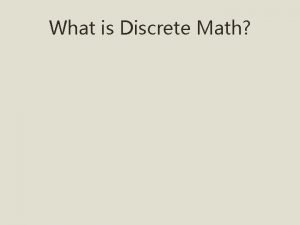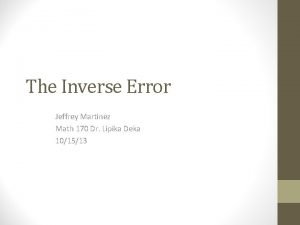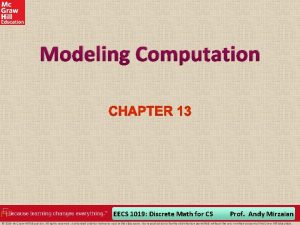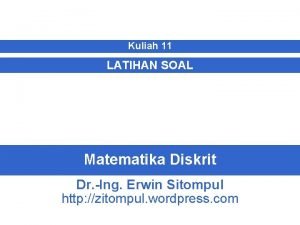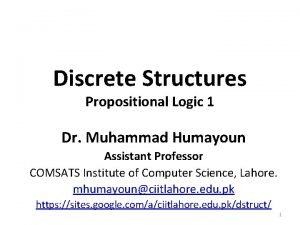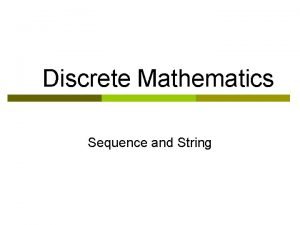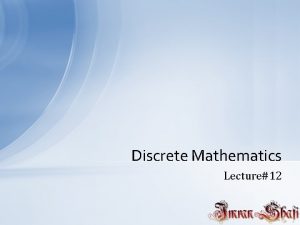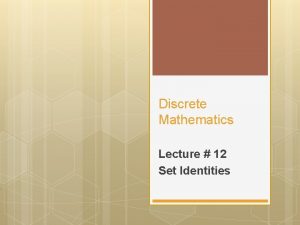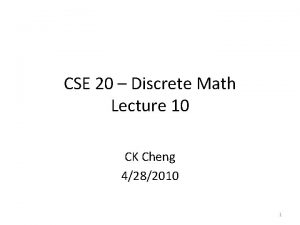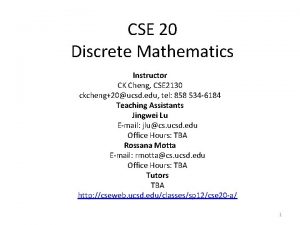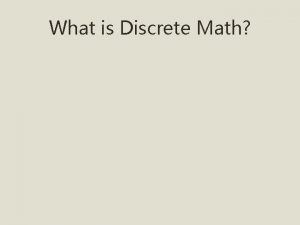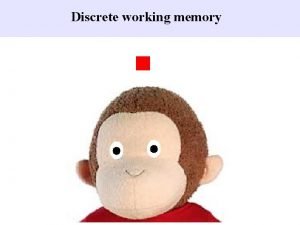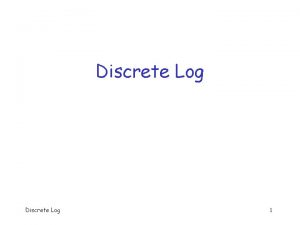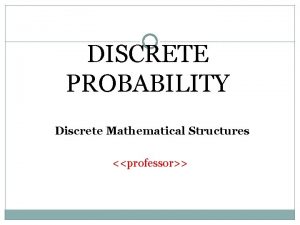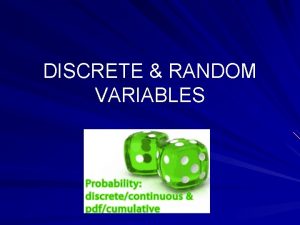CSE 20 Discrete Math Lecture 10 CK Cheng









- Slides: 9

CSE 20 – Discrete Math Lecture 10 CK Cheng 4/28/2010 1

Boolean Algebra Theorem: (Associative Laws) For elements a, b, c in B, we have a+(b+c)=(a+b)+c; a*(b*c)=(a*b)*c. Proof: Denote x = a+(b+c), y = (a+b)+c. We want to show that (1) ax = ay, (2) a’x = a’y. Then, we have x= 1*x=(a+a’)x= ax+a’x = ay+a’y= (a+a’)y= 1*y=y Shannon’s Expansion: (divide and conquer) We use a variable a to divide the term x into two parts ax and a’x. 2

Proof of (1) ax = ay ax = a (a+(b+c)) = a a + a (b+c) (Distributive) = a + a (b+c) (Idempotence) = a (Absorption) ay = a ((a+b)+c)) = a (a+b) + a c (Distributive) = (aa + ab) + ac (Distributive) = (a + ab) + ac (Idempotence) = a + ac (Absorption) = a (Absorption) Therefore: ax = ay 3

Proof of (2) a’x = a’y a’x = a’ (a+(b+c)) = a’ a + a’ (b+c) (Distributive) = 0+ a’(b+c) (Complementary) = a’(b+c) (Identity) a’y = a’ ((a+b)+c) = a’ (a+b) + a’ c (Distributive) = a’b+a’c (Theorem 8) = a’(b+c) (Distributive) Therefore: a’x = a’(b +c) = a’y 4

Boolean Transformation Minimize the expression: (abc+ab’)’(a’b+c’) =(a(bc+b’))’(a’b+c’) (distributive) =(a(b’+c))’(a’b+c’) (absorption) =(a’+bc’)(a’b+c’) (De Morgan’s) =a’b+a’c’+a’bc’+bc’ (distributive) =a’b+a’c’+bc’ (absorption) 5

Boolean Transformation (switching function) • ab’+b’c’+a’c’= ab’+a’c’ Proof: ab’+b’c’+a’c’ = ab’+ab’c’+a’c’ =ab’+a’c’ y=ab’+a’c’ We can use truth table when B={0, 1}, which is the case of digital logic designs. id a b c ab’ b’c’ a’c’ f 0 0 0 1 1 0 0 2 0 1 0 0 0 1 1 3 0 1 1 0 0 4 1 0 0 1 1 0 1 5 1 0 1 1 0 0 1 6 1 1 0 0 0 7 1 1 1 0 0 6

Boolean Transformation (switching function) • ab’+b’c’+a’c’= ab’+ab’c’+a’c’= ab’+a’c’ id a b c ab’ b’c’ a’c’ f 0 0 0 1 1 0 0 2 0 1 0 0 0 1 1 3 0 1 1 0 0 4 1 0 0 1 1 0 1 5 1 0 1 1 0 0 1 6 1 1 0 0 0 7 1 1 1 0 0 b, c 0, 0 0, 1 1, 0 a=0 1 0 0 1 a=1 1 1 0 0 K Map (CSE 140) 7

Boolean Transformation (switching function) • (a+b)(a+c’)(b’+c’)=(a+b)(b’+c’) id a b c a+b a+c’ b’+c’ f 0 0 0 1 1 0 0 1 0 2 0 1 1 1 1 3 0 1 1 1 0 0 0 4 1 0 0 1 1 5 1 0 1 1 1 6 1 1 0 1 1 7 1 1 1 0 0 b, c 0, 0 0, 1 1, 0 a=0 0 1 a=1 1 1 0 1 K Map (CSE 140) 8

Summary of Boolean Algebra • Definition: a set B, two operations and four postulates. • Applicability: set operations, logic reasoning, digital hardware synthesis and beyond. • Theorems: all proofs are derived from the four postulates. • Transformations: Boolean algebra for the hardware designs (cost and performance). • Switching function: truth table, K map (CSE 140) 9
 01:640:244 lecture notes - lecture 15: plat, idah, farad
01:640:244 lecture notes - lecture 15: plat, idah, farad Discrete mathematics
Discrete mathematics Inverse error fallacy
Inverse error fallacy Modeling computation discrete math
Modeling computation discrete math What is tautology in math
What is tautology in math Contoh soal diskrit
Contoh soal diskrit Discrete math propositional logic
Discrete math propositional logic Discrete math sequences
Discrete math sequences The inverse relation of r : a b is same as r, when:
The inverse relation of r : a b is same as r, when: How to prove set identities
How to prove set identities

